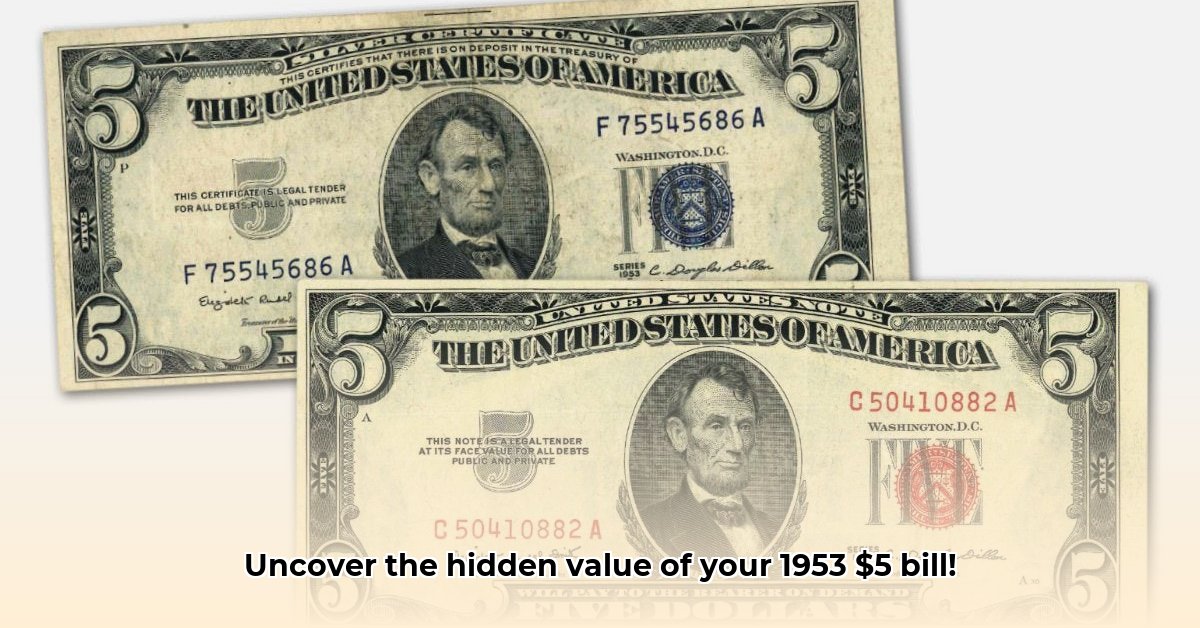
So, you've discovered a 1953 Series A $5 bill. Whether unearthed from a dusty attic or purchased at a flea market, its value could surprise you. This guide provides a step-by-step approach to assessing its worth, covering everything from identifying key features to understanding market dynamics.
Understanding the Nuances: More Than Just a Five-Dollar Bill
The 1953 $5 bill isn't monolithic. Four series exist (1953, 1953A, 1953B, 1953C), distinguished by the Treasury Secretary and Treasurer's signatures. While a worn bill might be worth only a few dollars, rare variations can command significantly higher prices. The details matter.
Key Factors Affecting Value: A Closer Look
Several factors significantly impact the value of your 1953 Series A $5 bill. Let's examine them:
Star Notes: A Lucky Find
A red star before the serial number, accompanied by an "A" at the end, signifies a "star note." These are replacement bills printed to correct production errors and are considerably rarer, thus more valuable than standard notes. Think of it as a rare variant of a collectible card.
Condition: A Critical Factor
A bill's condition is paramount. Numismatists (currency and coin experts) employ grading systems (e.g., Poor to Gem Uncirculated, or AU) to assess its preservation. A Gem Uncirculated bill is like a brand-new item; a Poor bill shows significant wear. Higher grades translate to higher values.
Fancy Serial Numbers: The Collector's Jackpot
Certain serial numbers are exceptionally valuable. "Fancy" serials might feature repeating digits (e.g., 1111111), low numbers (e.g., 000001), or palindromes (e.g., 12321). These are highly sought after by collectors and can dramatically increase a bill's worth. It's like hitting the jackpot in the currency collecting world. A particularly rare example, like a low-numbered star note, can significantly increase the value.
How to Appraise Your 1953 Series A $5 Bill: A Step-by-Step Guide
Follow these steps to estimate your bill's value:
- Identify the Series: Determine the series (A, B, or C) by examining the signatures of the Treasury Secretary and Treasurer. This initial identification limits potential value ranges.
- Star Note Check: Look for the red star and the trailing "A". Star notes immediately command higher prices than standard issues.
- Condition Assessment: Carefully examine the bill for wear, tears, stains, or creases. Use a reputable grading chart (available online) to determine its grade. Consider professional grading for potentially high-value pieces.
- Serial Number Analysis: Scrutinize the serial number. Does it exhibit a pattern (repeating digits, low numbers, palindromes)? Fancy serial numbers significantly increase value.
- Market Research: Consult online resources and auction results specializing in currency valuation. Cross-reference multiple sources for a well-rounded estimate. Websites specializing in numismatic valuation offer detailed data, but always consider professional appraisal for high-value bills.
Market Value: A Wide Spectrum of Possibilities
The value of your 1953 Series A $5 bill can vary dramatically. A circulated note may be worth just a few dollars, while a pristine star note with a fancy serial number could fetch hundreds or even thousands. The combination of series, condition, and serial number ultimately determines its value. Isn't it fascinating how such a simple piece of currency can have such a wide range of values?
Investing in Currency: Weighing the Risks and Rewards
Currency collecting, like any investment, carries risks. Market values fluctuate, and counterfeit bills are a concern. To mitigate risks:
- Diversify: Don't put all your "eggs" in one basket.
- Thorough Research: Understand market trends and pricing before buying or selling.
- Reputable Sources: Purchase from well-established and trusted sources to ensure authenticity.
Estimated Value Ranges (USD)
This table provides rough estimates; actual values may vary considerably:
| Condition | Common Note | Star Note | Fancy Serial Note |
|---|---|---|---|
| Circulated (Poor) | $5 - $10 | $20 - $50 | $50 - $200+ |
| Very Good (VG) | $10 - $20 | $50 - $150 | $150 - $500+ |
| Extremely Fine (XF) | $20 - $40 | $100 - $300 | $300 - $1000+ |
| Gem Uncirculated (AU) | $40+ | $300+ | $1000+ |
Remember, these are just guidelines. Accurate valuation requires considering all factors and potentially professional appraisal.
Conclusion: Unlocking the Potential of Your 1953 Series A $5 Bill
The world of currency collecting is rewarding yet requires careful consideration. By following this guide and conducting thorough research, you can significantly improve your understanding of your 1953 Series A $5 bill and its potential value. Happy collecting!